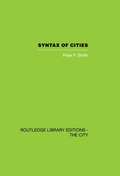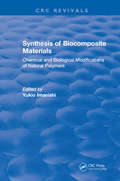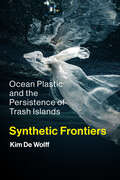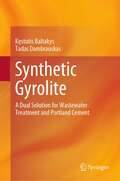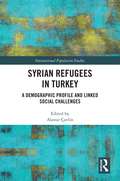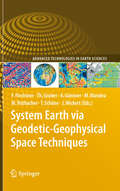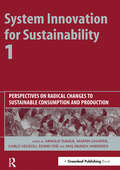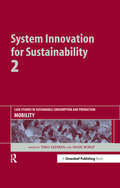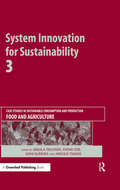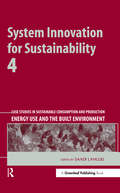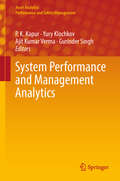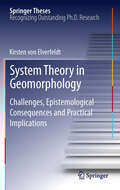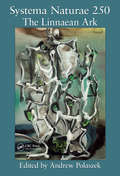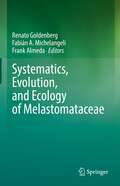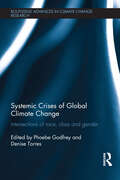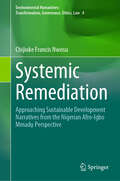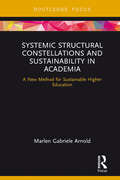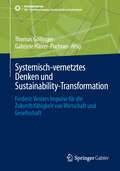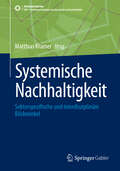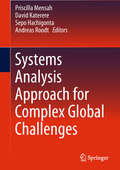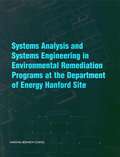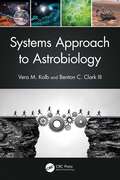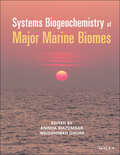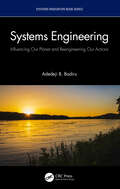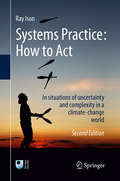- Table View
- List View
Synthesis of Biocomposite Materials: Chemical and Biological Modifications of Natural Polymers
by Yukio ImanishiBiomaterials have been used for artificial-organ and bioreactor materials, and have gained importance for enhancement of human welfare. This book summarizes research devoted to creating useful biofunctional materials by chemical modification of natural polymers, and forecasts future development.
Synthetic Frontiers: Ocean Plastic and the Persistence of Trash Islands
by Kim De WolffHow an imaginary island became the symbol of contemporary concern for ocean plastic pollution.A floating plastic island has become a powerful symbol of ocean pollution, but no one can find it at sea. While marine scientists dismiss the trash island as myth, Synthetic Frontiers argues that its persistence is a consequence of dominant ways of knowing and exploiting the Pacific Ocean. Bringing feminist science and technology studies approaches to materiality together with hydrohumanities critiques of terracentrism, Kim De Wolff shows how ocean plastic pollution is shaped by land/water divides and the fluidities that defy them.The trash island is no mere misrepresentation. It is a synthetic frontier: a territorial line of control that emerges with the products of modern science, and transforms crises of petrocapitalism into landscapes of so-called progress. As such, the story of the trash island—a story where knowledge and awareness of global ecological problems so often fail to instigate meaningful change—is simultaneously about the persistence of plastic pollution and all its associated harms. Where cleanup solutions recycle plastic into ever-more polluted landscapes, De Wolff proposes radically reclaiming synthetics from modern chemistry and modern philosophy in a refusal of elemental frontiers.
Synthetic Gyrolite: A Dual Solution for Wastewater Treatment and Portland Cement
by Kęstutis Baltakys Tadas DambrauskasThis book explores the topic of gyrolite and calcium silicate hydrates, focusing on their potential applications in wastewater purification and as additives in ordinary Portland cement. Divided into five chapters, the book provides a comprehensive description of calcium silicate hydrates and addresses challenges in reusing solid waste. It also covers the synthesis and application of gyrolite, offering technological recommendations for future studies. The results presented are supported by instrumental analysis techniques and thermodynamic calculations, allowing readers to delve into inorganic chemistry and materials characterization. The book is suitable for both researchers and students interested in chemistry and materials characterization, offering valuable insights and guidance in the field.
Syrian Refugees in Turkey: A Demographic Profile and Linked Social Challenges (International Population Studies)
by Alanur ÇavlinThis book examines the changing demographic situation of Syrian refugees and the host community in Turkey, one of the major refugee hosting countries in the world, relying on a recent representative dataset. Conflicts and the resulting unrest force people to flee their countries and take refuge in foreign lands. Such refugee movements across the world have increased significantly in recent times. Turkey accounts for the greatest refugee population in the world today. This has drastically impacted the Turkish demographics, leading to different demographic situations in refugee communities in the country. This book presents an in-depth research on the impact of forced displacement on the demographic behaviour of Syrian refugees in Turkey in general, and more specifically the way transformed family structures, unregistered children, fertility behaviours and early marriages impacted their lives. The book also contributes to the existing knowledge and discourse on refugee integration by shedding light on their experiences related to access to labour market opportunities and education opportunities, wellbeing and mobility. It also helps in linking demography of Syrian community to the socio-economic challenges in Turkey by means of incorporating crucial demographic variables into the analysis. Offering valuable insights into various dimensions of life, this book has an interdisciplinary appeal and will thus be a key resource for academics and scholars of demography, refugee studies, migration studies and sociology. It will also be a valuable and unique reference work for people in governments, international agencies and non-governmental organizations.
System Earth via Geodetic-Geophysical Space Techniques
by Frank M. Flechtner Jens Wickert Markus Rothacher Thomas Gruber M. Mandea Andreas Güntner Tilo SchöneThe Earth's magnetic and gravity field play an important role in global and regional geodynamics. Satellite exploration of these fields has received great attention in recent years. Research satellites such as CHAMP and GRACE as well as the ESA explorer GOCE apply new measurement techniques, thus allowing the recovery of the gravitational and magnetic field with unprecedented accuracy and resolution, spatial as well as temporal. Combined with terrestrial observations and computer models, this data will help develop a more detailed understanding of the Earth as a system. In Germany, many of the processing, modelling and interpreting methodologies for these new observation techniques are developed under the umbrella of the R&D-programme GEOTECHNOLOGIEN, funded by the Federal Ministry of Education and Research (BMBF). The research projects focus on a better understanding of the spatial and temporal variations in the magnetic and gravity field and their relationship to the dynamics of the Earth's interior and global change processes. This volume presents the results of the multidisciplinary studies covered by the programme for the period 2005-2008. It includes the following topics: High-accuracy gravity field models, near-real-time provision and usage of CHAMP and GRACE atmospheric sounding, sea level variations, improved GRACE gravity time series and their validation by ocean bottom pressure measurements, integration of space geodetic techniques as a basis for the Global Geodetic-Geophysical Observing System (GGOS), high-resolution magnetic field models and global magnetisation maps and time-variable gravity and surface mass processes.
System Innovation for Sustainability 1: Perspectives on Radical Changes to Sustainable Consumption and Production
by Carlo Vezzoli Martin Charter Eivind Stø Arnold Tukker Maj Munch AndersenSustainable consumption and production (SCP) was adopted as a priority area during the World Summit on Sustainable Development in Johannesburg in 2002 and has since become one of the main vehicles for targeting international sustainability policy. Sustainable consumption focuses on formulating equitable strategies that foster the highest quality of life, the efficient use of natural resources, and the effective satisfaction of human needs while simultaneously promoting equitable social development, economic competitiveness, and technological innovation. But this is a complex topic and, as the challenges of sustainability grow larger, there is a need to re-imagine how SCP policies can be formulated, governed and implemented. The EU-funded project "Sustainable Consumption Research Exchanges" (SCORE!) consists of around 200 experts in the field of sustainable innovation and sustainable consumption. The SCORE! philosophy is that innovation in SCP policy can be achieved only if experts that understand business development, (sustainable) solution design, consumer behaviour and system innovation policy work together in shaping it. Sustainable technology design can be effective only if business can profitably make the products and consumers are attracted to them. To understand how this might effectively happen, the expertise of systems thinkers must be added to the mix. System Innovation for Sustainability 1 is the first result of a unique positive confrontation between experts from all four communities. It examines what SCP is and what it could be, provides a state-of-the-art review on the governance of change in SCP policy and looks at the strengths and weaknesses of current approaches. The SCORE! experts are working with actors in industry, consumer groups and eco-labelling organisations in the key consumption areas of mobility, food and agriculture, and energy use and housing – responsible for 70% of the life-cycle environmental impacts of Western societies – with the aim of stimulating, fostering or forcing change to SCP theory in practice. The System Innovation for Sustainability series will continue with three further volumes of comprehensive case studies in each of these three critical consumption areas. Each chapter of this book examines problems and suggests solutions from a business, design, consumer and system innovation perspective. It primarily examines the differing solutions necessary in the consumer economies of the West, but also comments on the differing needs in rapidly emerging economies such as China, as well as base-of-the-pyramid economies. The System Innovation for Sustainability series is the fruit of the only major international research network on SCP and will set the standard in this field for some years to come. It will be required reading for all involved in the policy debate on sustainable production and consumption from government, business, academia and NGOs for designers, scientists, businesses and system innovators.
System Innovation for Sustainability 2: Case Studies in Sustainable Consumption and Production - Mobility
by Theo Geerken Mads BorupThe EU-funded project "Sustainable Consumption Research Exchanges" (SCORE!) consists of around 200 experts in the field of sustainable innovation and sustainable consumption. The SCORE! philosophy is that innovation in SCP (sustainable consumption and production) policy can be achieved only if experts that understand business development, (sustainable) solution design, consumer behaviour and system innovation policy work together in shaping it. Sustainable technology design can be effective only if business can make the products profitably and consumers are attracted to them. To understand how this might effectively happen, the expertise of systems thinkers must be added to the mix. The publication in 2008 of System Innovation for Sustainability 1 was the first result of a unique positive confrontation between experts from all four communities. It examined what SCP is and what it could be, provided a state-of-the-art review on the governance of change in SCP policy and looked at the strengths and weaknesses of current approaches. System Innovation for Sustainability 2 is the first of three books of case studies covering, respectively, the three key consumption areas of: mobility; food and agriculture; and energy use and housing. These three areas are responsible for 70% of the life-cycle environmental impacts of Western societies. These case studies aim to stimulate, foster or force change to SCP theory in practice. System Innovation for Sustainability 2 focuses on change towards sustainable personal mobility based on implemented cases analysed from a system perspective. It examines what changes can be made to help us reduce our need for mobility, or start to make use of more sustainable mobility systems. This is clearly a critical and highly problematic area, as increasing living standards of a growing global population have resulted in rapid rises in both car and air travel along with the associated pollution. Uniquely, this book approaches the problems and solutions from a systems perspective, explaining the meta-trends, specific issues for the mobility sector, socioeconomic trends, political considerations, socio-cultural developments and environmental issues. As well as the mobility system itself, other societal systems that impact the need for mobility, such as labour and taxation, are addressed in order to provide sustainable solutions to our current "lock-in" problems. Three major problem areas are considered (the "three Cs"): carbon emissions (and the growing contribution of mobility to the climate change crisis), congestion, and casualties. And each strategy proposed addresses one or more of these problem areas. Among the cases discussed are: Norway's carbon compensation scheme for air travel; Madrid's high-occupancy vehicle lanes; London's congestion charge scheme; market-based instruments such as eco-labelling for cars; and taxation. The book identifies opportunities for actors such as governments, manufacturers and consumers to intervene in the complex system to promote sustainable mobility. It concludes with a reflection on problems, trends and action needed. The System Innovation for Sustainability series is the fruit of the first major international research network on SCP and will set the standard in this field for some years to come. It will be required reading for all involved in the policy debate on sustainable production and consumption from government, business, academia and NGOs for designers, scientists, businesses and system innovators.
System Innovation for Sustainability 3: Case Studies in Sustainable Consumption and Production — Food and Agriculture
by Ursula Tischner Eivind Stø Unni Kjærnes Arnold TukkerThe EU-funded project "Sustainable Consumption Research Exchanges" (SCORE!) consists of around 200 experts in the field of sustainable innovation and sustainable consumption. The SCORE! philosophy is that innovation in SCP policy can be achieved only if experts that understand business development, (sustainable) solution design, consumer behaviour and system innovation policy work together in shaping it. Sustainable technology design can be effective only if business can profitably make the products and consumers are attracted to them. To understand how this might effectively happen, the expertise of systems thinkers must be added to the mix. The publication in 2008 of System Innovation for Sustainability 1 was the first result of a unique positive confrontation between experts from all four communities. It examined what SCP is and what it could be, provided a state-of-the-art review on the governance of change in SCP policy and looked at the strengths and weaknesses of current approaches. System Innovation for Sustainability 3 is the second of three books of case studies covering respectively the three key consumption areas of mobility, food and agriculture, and energy use and housing – responsible for 70% of the life-cycle environmental impacts of Western societies – with the aim of stimulating, fostering or forcing change to SCP theory in practice. The availability of healthy food for all is a basic human need. Yet, primarily due to higher food prices, the overall number of undernourished people in the world increased from 923 million in 2007 to 963 million in 2008 – the vast majority of whom live in developing countries. Experts estimate that close to half of the human impact on the environment is directly or indirectly related to food production and consumption. Food production, distribution, consumption and disposal are important in terms of land and resource use, pollution and emissions, biodiversity and landscape design. Also of key importance are health issues and issues surrounding the satisfaction of citizens' basic needs: more than 200 million adults in the European Union are overweight or even obese due to unhealthy diets and too little exercise. Sustainability issues are now clearly on the agenda for food producers and market actors, politicians and regulators, as well as being increasingly important in the decisions consumers make about food. A large number and variety of efforts to stimulate sustainability have been instigated and numerous studies, research programmes and publications have addressed such issues. Agri-food issues have also been prominent in the evolving definition of what sustainability means. This book focuses largely on providing answers to the question of how food production and consumption systems can stay within the limits of the carrying capacity of our natural environment. But it also considers the challenges of food security and nutrition in the context of sustainability and a growing world population. The book first analyses the state of the art in sustainable agriculture and food production in Europe. Eleven case studies follow, examining issues such as food policy, greening mainstream agricultural systems, organic farming, farmers' markets, sustainable food networks, eco-labelling, consumer behaviour, slow food and fair trade. Finally, a concluding chapter summarises what has been learned by the 60-plus experts active in the SCORE! food project. In brief: bottom-up and top-down processes have to be linked, industrialised nations must reduce their meat consumption, and agriculture should become a multifunctional sustainable system not only producing food but also delivering other services such as energy and material production, CO2 storage and recreation – which would have the added benefit of improving farmers' socioeconomic situations. The System Innovation for Sustainability series is the fruit of the first major international research network on SCP and will set the standard in this field for some years to come. It will be required reading
System Innovation for Sustainability 4: Case Studies in Sustainable Consumption and Production — Energy Use and the Built Environment
by Saadi LahlouThe EU-funded project "Sustainable Consumption Research Exchanges" (SCORE!) consists of around 200 experts in the field of sustainable innovation and sustainable consumption. The SCORE! philosophy is that innovation in SCP policy can be achieved only if experts that understand business development, (sustainable) solution design, consumer behaviour and system innovation policy work together in shaping it. Sustainable technology design can be effective only if business can profitably make the products and consumers are attracted to them. To understand how this might effectively happen, the expertise of systems thinkers must be added to the mix. The publication in 2008 of System Innovation for Sustainability 1 was the first result of a unique positive confrontation between experts from all four communities. It examined what SCP is and what it could be, provided a state-of-the-art review on the governance of change in SCP policy and looked at the strengths and weaknesses of current approaches. System Innovation for Sustainability 4 is the third of three books of case studies covering respectively the three key consumption areas of mobility, food and agriculture, and energy use and the built environment – responsible for 70% of the life-cycle environmental impacts of Western societies – with the aim of stimulating, fostering or forcing change to SCP theory in practice. Energy consumption is obviously a key issue for sustainability, primarily because it depletes non-renewable fossil fuels, produces CO2 and other pollution. As climate change is becoming a key political issue, and as oil prices rise, society has become acutely aware of this issue. Energy is a special case because it is a key input to almost all other consumption and production processes. Housing is, with transport and food, a major consumer of energy, accounting for about one quarter of the environmental impact from the general consumption of products in the European Union, on a par with food and transport. Energy use in houses and buildings is also set to rise as populations – and the buildings they need –continue to increase. In France, for example, energy consumption in houses and offices accounts for 43% of the total national energy consumption, and one-quarter of national greenhouse gas emissions. The UK's 21 million homes consume around 50 million tonnes of oil equivalent (responsible for 27% of UK CO2 emissions); this energy use has increased steadily by about 1.3% per year since 1990. Germany's buildings contribute one-fifth of the country's CO2 emissions. Beyond this, buildings are the environment where we spend most of our lives; they deeply influence many other consumption patterns, and are an important factor for life and comfort. The societal function and nature of buildings as they are currently constructed presents some key difficulties in moving towards sustainable consumption and production. Buildings have a long lifetime; and therefore they are a major target for any structural changes in consumption patterns. Conversely, long lifetimes come with associated strong inertia; therefore the stock of existing buildings is often an obstacle to policies aimed at behavioural change. This book examines, through a case study approach, opportunities to influence energy consumption in housing and buildings and thereby provide options for implementation at a macro, meso and micro level. A growing body of evidence shows that cases demonstrating action towards SCP in energy use in housing can inspire innovation through a range of actors. The cases include examples of steps towards the sustainable use of energy in houses and buildings, from "local experiments", to "innovative communities", to wider regime or non-local scale change in Europe and North America. The System Innovation for Sustainability series is the fruit of the first major international research network on SCP and will set the standard in this field for some years to come. It will be required reading for all involved in the policy debate on sustainable product
System Performance and Management Analytics (Asset Analytics)
by Ajit Kumar Verma P. K. Kapur Yury Klochkov Gurinder SinghThis book shares key insights into system performance and management analytics, demonstrating how the field of analytics is currently changing and how it is used to monitor companies’ efforts to drive performance.Managing business performance facilitates the effective accomplishment of strategic and operational goals, and there is a clear and direct correlation between using performance management applications and improved business and organizational results. As such, performance and management analytics can yield a range of direct and indirect benefits, boost operational efficiency and unlock employees’ latent potential, while at the same time aligning services with overarching goals.The book addresses a range of topics, including software reliability assessment, testing, quality management, system-performance management, analysis using soft-computing techniques, and management analytics. It presents a balanced, holistic approach to viewing the world from both a technical and managerial perspective by considering performance and management analytics. Accordingly, it offers a comprehensive guide to one of the most pressing issues in today’s technology-dominated world, namely, that most companies and organizations find themselves awash in a sea of data, but lack the human capital, appropriate tools and knowledge to use it to help them create a competitive edge.
System Theory in Geomorphology
by Kirsten Von ElverfeldtEmpirical research needs a profound theory to be successful. This is the simple but, in its consequences, radical approach for this study in geomorphology. It critically analyses the current system understanding and offers a new view for a geomorphology that understands systems as being open but at the same time operationally closed, as self-organized, structure-building and potentially self-referential. Kirsten von Elverfeldt succeeds in designing a theoretical framework that sets new standards within Physical Geography. By using state-of-the-art concepts in system theory, it offers also new bridges to Human Geography as well as to other neighbouring disciplines. This book was awarded the Dissertation prize 2010 of the German Working Group in Geomorphology of the DGfG and the Hans Bobek-prize of the ÖGG (Austrian Geographical Society).
Systema Naturae 250 - The Linnaean Ark
by Andrew PolaszekThe advent of relational databasing and data storage capacity, coupled with revolutionary advances in molecular sequencing technology and specimen imaging, have led to a taxonomic renaissance. Systema Naturae 250 - The Linnaean Ark maps the origins of this renaissance, beginning with Linnaeus, through his "apostles", via the great unsung hero Charl
Systematics, Evolution, and Ecology of Melastomataceae
by Renato Goldenberg Fabián A. Michelangeli Frank AlmedaThis book presents a synthesis of critical new information for the Melastomataceae, one of the ten richest families among flowering plants with over 5,800 species that has its diversity highly concentrated in tropical or subtropical areas. It describes the family’s global diversity and distribution and summarizes recent advances in systematics, evolution, biogeography, reproductive biology and ecology.
Systemic Crises of Global Climate Change: Intersections of race, class and gender (Routledge Advances in Climate Change Research)
by Phoebe Godfrey Denise TorresSociological literature tends to view the social categories of race, class and gender as distinct and has avoided discussing how multiple intersections inform and contribute to experiences of injustice and inequity. This limited focus is clearly inadequate. Systemic Crises of Global Climate Change is an edited volume of 49 international, interdisciplinary contributions addressing global climate change (GCC) by intentionally engaging with the issues of race, gender, and class through an intersectional lens. The volume challenges and inspires readers to foster new theoretical and practical linkages and think beyond the traditional, and oftentimes reductionist, environmental science frame by examining issues within their turbulent political, cultural, and personal landscapes. Varied media and writing styles invite students and educators to reflexively engage different, yet complementary, approaches to GCC analysis and interpretation, mirroring the disparate voices and viewpoints within the field. The second volume, Emergent Possibilities for Sustainability will take a similar approach but will examine the possibilities for solutions, as in the quest for global sustainability. This book is a valuable resource for academics, researchers and both undergraduate and post-graduate students in the areas of Environmental Studies, Climate Change, Gender Studies and International studies as well as those seeking a more intersectional analysis of GCC.
Systemic Remediation: Approaching Sustainable Development Narratives from the Nigerian Afro-Igbo Mmadụ Perspective (Environmental Humanities: Transformation, Governance, Ethics, Law #4)
by Chijioke Francis NwosuSince the issues and discourses surrounding sustainable development entered its phase in our contemporary world, the political, social, economic, ecological, and cultural existence of our modern world has inevitably adopted varied measures to respond better to the demands of our time. This book contributes to the global call for transitions and transformations towards a more sustainable human society. This contribution is specific, dialogic and comparative and also has deep cultural and ethnological consciousness based on the Nigerian experiences and, by extension, the African experience. The research work presents as its background the hypothesis that varied forms of structures—socio-political, socio-economic, socio-ecological and socio-cultural—unite to constitute ‘structural sins’ (John Paul II) and, consequently, the banes to authentic and sustainable development. These dysfunctional structures were critically analysed and evaluated. Furthermore, the research work takes up the contemporary discourse on sustainable development, beginning with earlier development concepts, the impactful contribution of social documents of the church to development discourse, the timeline of the general global and sustainable development approach and governance, as well as the specifics of the twin documents of the year 2015, namely Agenda 2030 and Laudato Si. Again, an indigenised manuscript for development discourse known as Nigeria Vision 20:2020 was examined to delineate the fact that forms of indigenous efforts to discuss and administrate the development process are noticeable. However, such efforts have remained negatively exploited by both internal and external man-made corrupt factors. One such factors discussed in this book, among others, is the failure of Nigeria since independence to stabilise its power and energy sector.
Systemic Structural Constellations and Sustainability in Academia: A New Method for Sustainable Higher Education
by Marlen ArnoldIn order to create truly sustainable universities, we require new methods of visualising and interpreting them holistically as institutions built on complex relationships and systems, rather than as individual departments and people operating independently. This book uses a systemic structural constellations approach to demonstrate how we can build more sustainable higher education institutions, both in terms of teaching and research and at an operational level. Drawing examples from current research and teaching, Systemic Structural Constellations and Sustainability in Academia explores how universities are not only centres of teaching and learning but can also play a crucial role in enabling future decision-makers to appreciate and contribute to a more sustainable future. Providing a clear introduction to systemic structural constellations and guidance on how to practically apply the theory to numerous aspects of the higher education system, this book will be of great interest to students and researchers of education for sustainable development, organisational learning and sustainable management, as well as those tasked with transforming the higher education system for the future.
Systemisch-vernetztes Denken und Sustainability-Transformation: Frederic Vesters Impulse für die Zukunftsfähigkeit von Wirtschaft und Gesellschaft (SDG - Forschung, Konzepte, Lösungsansätze zur Nachhaltigkeit)
by Thomas Göllinger Gabriele Harrer-PuchnerDieses Buch bietet eine Darstellung von Frederic Vesters einflussreichen Arbeiten zum systemischen Denken und zur Sustainability-Transformation. Anlässlich des 100. Geburtstages dieses visionären Vordenkers versammelt der Band aktuelle Beiträge von Kolleginnen und Kollegen, Mitstreitern, Freunden und kritischen Begleitern, die dessen Einfluss auf das systemorientierte Management und die ökologische Transformation beleuchten. Sie geben eine Einführung in den Systemansatz Frederic Vesters und die Anwendung seiner Methodik, die in der heutigen Zeit der Krisen und Transformationen aktueller denn je sind. Im Mittelpunkt der insgesamt 17 Beiträge stehen zentrale Konzepte des Systemdenkens und der Nachhaltigen Entwicklung, die unter Überschriften wie „Systemdenken und konzeptionelle Sustainability-Themen&“ und „Vesters Sensitivitätsmodell – Konzepte und Tools&“ vertieft werden. Fragen zur nachhaltigen Mobilität, Stadtgesundheit, Lebensmittelproduktion, Humanökologie, Energiewende und Bioökonomie werden ebenso behandelt wie die Herausforderungen komplexer politischer Entscheidungen. Methodische Beiträge zum Vernetzten Denken, zum Sensitivitätsmodell, zu Planspielen und zu Softwaretools zeigen, wie Vesters Ansätze durch neue wissenschaftliche Erkenntnisse erweitert werden können. Das Buch richtet sich an Wissenschaftler, Praktiker und Studierende, die sich mit systemischem Denken und nachhaltiger Entwicklung befassen. Es bietet wertvolle Einblicke und praxisorientierte Beispiele, die dazu inspirieren, Vesters Methoden in ihren eigenen Arbeitsbereichen anzuwenden.
Systemische Nachhaltigkeit: Sektorspezifische und interdisziplinäre Blickwinkel (SDG - Forschung, Konzepte, Lösungsansätze zur Nachhaltigkeit)
by Matthias KramerDie Auswirkungen des Klimawandels sind längst mehr als nur ein gefühltes Phänomen. Sie zeigen sich weltweit mit zunehmender regionaler Intensität. Deutschland ist aktuell besonders von Starkregenereignissen mit Überschwemmungskatastrophen und Dürreperioden mit massiven Waldschäden betroffen. Die notwendige Reduzierung klimarelevanter Emissionen artikuliert sich u. a. in Maßnahmen zur Verkehrswende, Bau- und Infrastrukturwirtschaft, Landwirtschaft und zum Konsumentenverhalten. Zielkonflikte, wie beim Übergang vom fossilen Zeitalter zu Erneuerbaren Energien und von weniger Globalisierung zu mehr Regionalisierung, gilt es durch eine simultane Planung von Klima-, Umwelt- und Naturschutz wirtschaftswissenschaftlich orientiert zu managen. Dieser Anspruch und die Fokussierung auf mehrere SDGs im Rahmen der nachhaltigen Entwicklung stellen die fachlichen Schnittstellen zwischen den Buchbeiträgen dar. Das Buch richtet sich an Studierende, Wissenschaftler, politische Entscheidungsträger und Praktiker, die sich mit Nachhaltigkeitsthemen sowie den interdisziplinären Auswirkungen des Klimawandels befassen.
Systems Analysis Approach for Complex Global Challenges
by Priscilla Mensah David Katerere Sepo Hachigonta Andreas RoodtThis book, which contains a collection of review articles as well as focus on evidence-based policy making, will serve as a valuable resource not just for all postgraduate students conducting research using systems analysis thinking but also for policy makers. To our knowledge, a book of this nature which also has a strong African focus is currently not available. The book examines environmental and socio-economic risks with the aim of providing an analytical foundation for the management and governance of natural resources, disasters, addressing climate change, and easing the technological and ecological transitions to sustainability. It provides scientific and strategic analysis to better understand the dynamics of future energy transitions, their main driving forces, enabling factors, barriers, as well as their consequences for the social, economic and environmental dimensions of human wellbeing. Science-based policy advice is achieved through an integrated assessment and modeling of how to simultaneously address the major energy policy challenges in the areas of environment (climate change and air pollution), energy poverty (or access to affordable and clean energy for the poor), energy security and reliability. It also aims to improve our understanding of ecosystems and their management in today’s changing world—in particular, the current state of ecosystems, and their ecological thresholds and buffering capacities. It provides support for policy makers in developing rational, realistic and science-based regional, national and global strategies for the production of fuel, food and fibre that sustain ecosystem services and safeguard food security. Finally, it addresses the human development dimension of global change based on comprehensive studies on the changing size and composition of human populations around the world by analyzing both their impacts and the differential vulnerabilities by age, gender and level of education.
Systems Analysis and Systems Engineering in Environmental Remediation Programs at the Department of Energy Hanford Site
by Tank Wastes Committee on Remediation of BuriedInformation on Systems Analysis and Systems Engineering in Environmental Remediation Programs at the Department of Energy Hanford Site
Systems Approach to Astrobiology
by Vera M. Kolb Benton C. ClarkSystems thinking/analysis is widely applied for solving complex problems in engineering and certain other fields. Astrobiology, which inherently involves complex problems, can benefit from such an approach.
Systems Biogeochemistry of Major Marine Biomes
by Aninda Mazumdar Wriddhiman GhoshSystems Biogeochemistry of Major Marine Biomes A comprehensive system-level discussion of the geomicrobiology of the Earth’s oceans In Systems Biogeochemistry of Major Marine Biomes, a team of distinguished researchers delivers a systemic overview of biogeochemistry across a number of major physiographies of the global ocean: the waters and sediments overlying continental margins; the deep sub-surfaces; the Arctic and Antarctic oceans; and the physicochemical extremes such as the hypersaline and sulfidic marine zones, cold methane seeps and hydrothermal ecosystems. The book explores state-of-the-art advances in marine geomicrobiology and investigates the drivers of biogeochemical processes. It highlights the imperatives of the unique, fringe, and cryptic processes while studying the geological manifestations and ecological feedbacks of in situ microbial metabolisms. Taking a holistic approach toward the understanding of marine biogeochemical provinces, this book emphasizes the centrality of culture-dependent and culture-independent (meta-omics-based) microbiological information within a systems biogeochemistry framework. Perfect for researchers and scientists in the fields of geochemistry, geophysics, geomicrobiology, oceanography, and marine science, Systems Biogeochemistry of Major Marine Biomes will also earn a place in the libraries of policymakers and advanced graduate students seeking a one-stop reference on marine biogeochemistry.
Systems Engineering: Influencing Our Planet and Reengineering Our Actions (Systems Innovation Book Series)
by Adedeji B. BadiruPeople want to create a better world and planet; however, where, and how to start remains the question. Systems Engineering’s problem-solving methodology can help with its ability to answer multiple questions along with connecting actions and impacts. This book uses the Systems Engineering problem-solving methodology to frame how each answer impacts the planet when multiple actions are strung together no matter where they take place. Systems Engineering: Influencing Our Planet and Reengineering Our Actions illustrates a hierarchical Systems Engineering view of the world with each individual in mind as a link in the chain. It uses an Industrial Engineering framework for action implementations and identifies humans’ interconnected actions. The book discusses the implementation of the Systems Engineering problem-solving methodology and leverages existing concepts of environmental sustainability. A template is present for personal actions for environment social responsibility using a Systems Engineering problem-solving approach and focuses on the foundational use of the trademarked DEJI Systems Model® for action design, evaluation, justification, and integration. This book is a perfect read for all academic disciplines and all engineering fields, as well as business and management fields. It reminds us of the Environmental Foundation of NAE’s 14 Grand Challenges and the part we can play.
Systems Practice: How to Act
by Ray IsonIt is now accepted that humans are changing the climate of the Earth and this is the most compelling amongst a long litany of reasons as to why, collectively, we have to change our ways of thinking and acting. Most people now recognise that we have to be capable of adapting quickly as new and uncertain circumstances emerge: this capability will need to exist at personal, group, community, regional, national and international levels, all at the same time. Systems Practice is structured into four parts. Part I introduces the societal need to move towards a more systemic and adaptive governance against the backdrop of human-induced climate change. Part II unpacks what is involved in systems practice by means of a juggler metaphor; examining situations where systems thinking offers useful understanding and opportunities for change. Part III identifies the main factors that constrain the uptake of systems practice and makes the case for innovation in practice by means of systemic inquiry, systemic action research and systemic intervention. The book concludes with Part IV, which critically examines how systems practice is, or might be, utilised at different levels from the personal to the societal. The development of our capabilities to think and act systemically is an urgent priority and Systems Practice aims to show how to do systems thinking and translate that thinking into praxis (theory informed practical action) which will be welcomed by those managing in situations of complexity and uncertainty across all domains of professional and personal concern.
